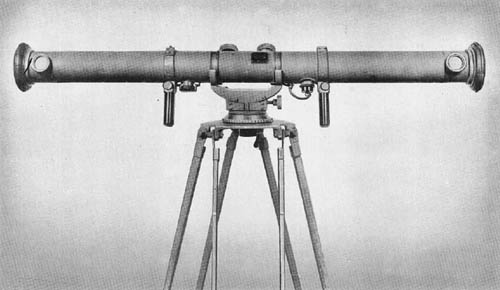
This instrument is very similar to the 80 cm base range finder, Keuffel and Esser Model 1918. It also resembles the design of the Barr and Stroud instrument. It is, therefore, assumed that it is used much the same as the American 80 cm base, M1914M1 Range Finder. It is a coincidence type range finder with a split field of view, and is used by light field artillery units.
The ocular prism consists of three optical components cemented together resembling the arrangement in the American 1 meter base range finder, M1916. The eyepiece assembly is of the symmetrical type. The halving plate is a thick piece of optical glass with plano parallel surfaces. The measuring wedge and range scale are a single assembly. The latter is illuminated by the light rays entering through the range scale illuminating window, and reflected by a mirror. The objectives, installed as matched pairs are burnished in their cells. The penta prisms and wedge windows resemble those used in American range finders.
An effort has been made, through a bushing in the center of the buffer assemblies, to desiccate the instrument. It is not believed that the eyepiece assemblies can be sufficiently sealed to make this effective.
The tripod is lightly constructed and has no locking device for the legs. The tripod mount permits the range finder to be locked or rotated in azimuth. There is also a leveling device, but no level vial.
SPECIFICATIONS
| Base length | 75 cm | |
| Magnification | 12 power | |
| Range | 100 to 10,000 yds. | |
| Field of view | Vertical 2°—horizontal 3° | |
| Weight of range finder | 9 lbs. | |
| Weight of carrying case | 6 lbs. |
Japanese: p. 180 (March 1, 1945)